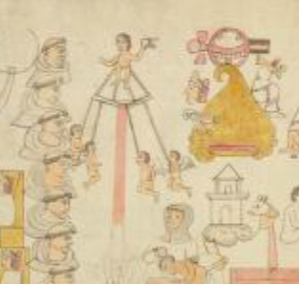cuauhpatlanihuac (Azca31)
This painted black-line drawing is an unglossed iconographic example of a ritual that the Spanish colonizers called palo de voladores (a stick with flyers), and our dictionary calls cuauhpatlanihuac. In this example, a vertical, probably wooden pole, painted red or dark pink, has a man sitting on a structure at the top. In our dictionary, the pole is referred to as a cuauhpatlanilizcuahuitl. He is wearing a loincloth. He holds an object–perhaps a ball with two feathers–aloft in his left hand. His skin is a flesh tone. The structure is made of wood and ropes, seemingly formed in a square shape. From each corner a man attached to a rope is suspended. These four men (which our dictionary would define as cuauhpatlanque, also seen in the singular as cuapatlanqui) wear only white wings, creating an image of a human bird. Their heads are up, so they are not diving while flying, as happens in some rituals in modern times.
Stephanie Wood
The various terms in the Online Nahuatl Dictionary that address this ritual will start with either cua- (head) or cuauh- (eagle), leaving some question as to whether they people who fly are flying by their head or head first, or flying in imitation of eagles. The person atop the central axis and the four men who “fly” comprise something of a quincunx, possibly in recognition of Nahua thinking about the cosmos with its four cardinal directions and a vertical axis connecting the surface of the Earth with the underworld and the celestial realm. Writing in the early seventeenth century, Chimalpahin refers to a group of Dominican friars who observed a ritual such as this one, and the contextualizing image also shows a group of friars observing this event. This may raise the question as to whether this artist was drawing something he read about or heard about in the early seventeenth century.
For comparison, see a vaguely similar festival activity presented in the Códice Durán, published in a vignette by Marc Thouvenot, https://vignettes.sup-infor.com/imagen/DU_02_276r_a.
Stephanie Wood
post-1550, possibly from the early seventeenth century.
Jeff Haskett-Wood
voladores, palos, alas, quincunces, religión indígena
cuauhpatlanihuac, religious ritual involving what Spaniards named the palo de voladores, https://nahuatl.wired-humanities.org/content/cuauhpatlanihuac
cuapatlanqui, one of the flyers in this ritual, https://nahuatl.wired-humanities.org/content/cuapatlanqui
cuauhpatlanilizcuahuitl, pole in the volador ritual, https://nahuatl.wired-humanities.org/content/cuapatlanalizcuahuitl
el ritual de los voladores
Stephanie Wood
The Codex Azcatitlan is also known as the Histoire mexicaine, [Manuscrit] Mexicain 59–64. It is housed in the Bibliothèque Nationale de France, and hosted on line by the World Digital Library and the Library of Congress, which is “unaware of any copyright or other restrictions in the World Digital Library Collection.”
https://www.loc.gov/resource/gdcwdl.wdl_15280/?sp=31&st=image
The Library of Congress is “unaware of any copyright or other restrictions in the World Digital Library Collection.” But please cite Bibliothèque Nationale de France and this Visual Lexicon of Aztec Hieroglyphs.

